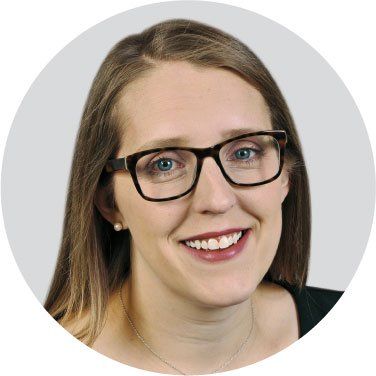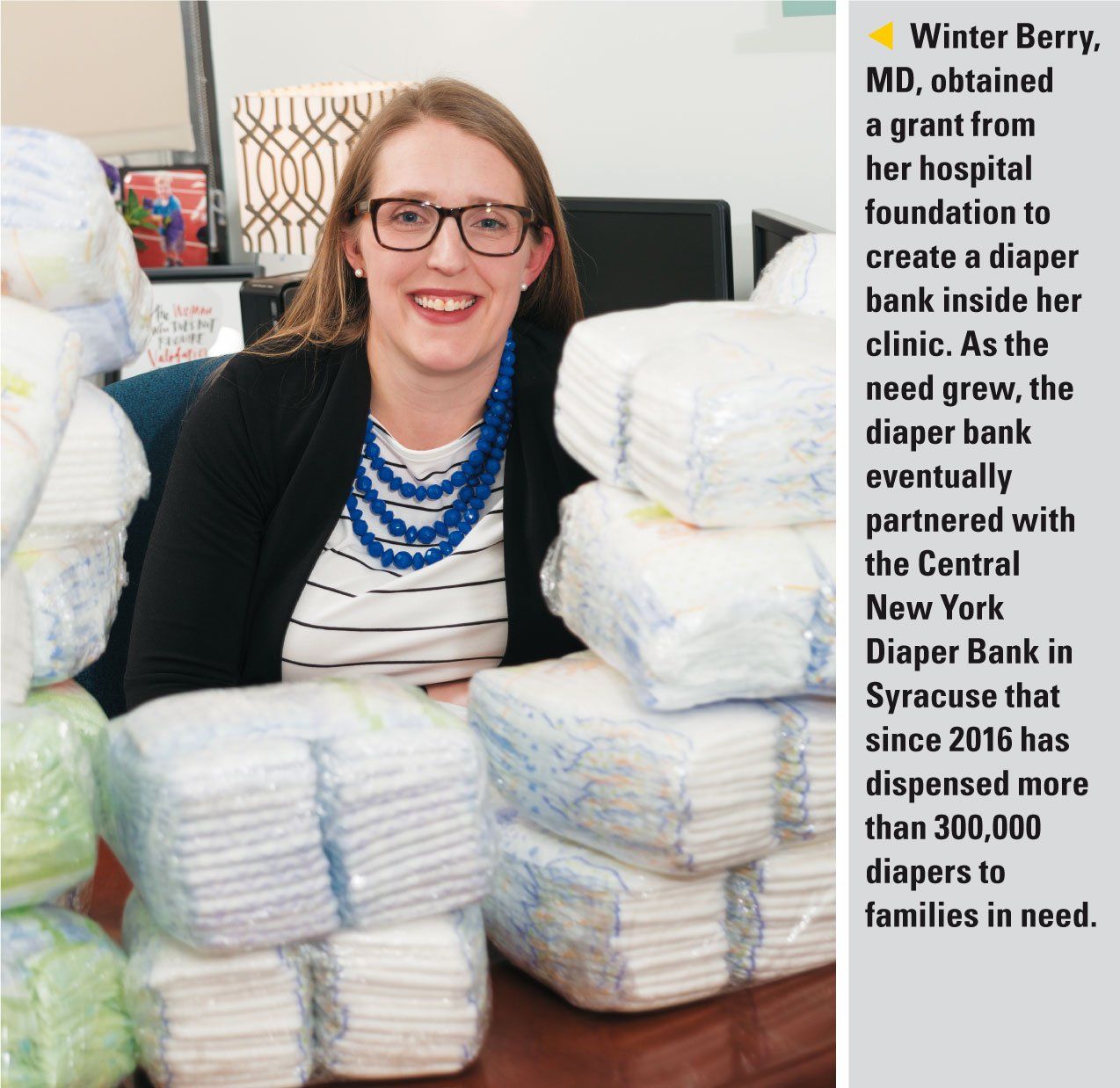Pediatric change makers: Winter Berry, DO
For Winter Berry, DO, addressing diaper need in urban Syracuse was just the start of her child advocacy work.
In honor of our magazine’s founder, Frank A. Oski, MD, Contemporary Pediatrics has initiated an annual award for pediatricians who exemplify his tireless advocacy for children. Here is another winner of this year’s Frank A. Oski, MD, Children’s Advocacy Award. For more profiles about these amazing pediatric change makers, go to contemporarypediatrics.com/oski-award

Dr BerryFor Winter Berry, DO, advocating for children and their families started on a small scale, in poverty-challenged Syracuse, New York, with mountains of diapers in her clinic.
Today, the determined pediatrician is hoping to develop her skills to take her messages of need to US policymakers and legislatures-to make widespread change in the lives of children and families.
Berry, one of the clinical pioneers nominated for this year’s Contemporary Pediatrics Frank A. Oski Children’s Advocacy Award, stands out as a child advocate because of her passion and selflessness, says the pediatrician who nominated her, Elizabeth Nelsen, MD.
“There is no hesitation when she acts to improve the lives of others,” says Nelsen, who, like Berry, is an assistant professor of pediatrics, Upstate Pediatric and Adolescent Center, at the State University of New York (SUNY) Upstate Medical Center, in Syracuse.
Child advocacy is part of Berry’s daily work as a pediatrician and educator, according to Berry’s colleague. “Dr. Berry expects nothing in return for her work, but she is nonetheless deserving of recognition and honor,” Nelsen tells Contemporary Pediatrics.
Falling in love with Syracuse
Berry first came to Syracuse for clinical rotations during medical school, then for her residency training between 2010 and 2013. She stayed on as faculty because, she says, she fell in love with the patient population and teaching.
Whereas Berry was drawn by medical education and caring for Syracuse families, the city was not without opportunities for advocacy. At the time, Syracuse was infamous for its poverty. “There were census studies and national population studies around poverty that happened to be published around the time I first became faculty. I don’t think it was news to anyone in Syracuse, but the studies showed that about 50% of children in Syracuse were in poverty, and that Syracuse had the highest concentrations of black and Hispanic poverty in the country,” Berry says.
A basic need for diapers
As pediatric researchers, nationwide, focused on poverty’s effects on child health, Berry was at the front line, witnessing families’ struggles. An experience she had working as a resident made her feel helpless and fueled Berry’s desire to help.
“I was the on-call physician and took a call from a mom. She said her child had a stomach bug, and she had gone through an entire supply of diapers. She couldn’t afford any more, and her child was in a plastic bag, in place of a diaper. She wanted to know if there was anything I could do to help, or if there was anywhere I could send her. At the time . . . there wasn’t anywhere in the community to be able to reliably send families,” Berry says.
An article a year later in Contemporary Pediatrics about diaper banks1 would spur the now faculty member into action.
“We have a current events conference that we do for the residents, where we bring recent articles to the trainees to discuss current events. One of the articles in the summer of 2014 was about the concept of diaper need and people establishing diaper banks,” Berry says. “It was written at the time by someone who was a national diaper bank network member-so, very much ahead of the curve on the concept of diaper need, which didn’t become more commonplace until later. After reading the article and discussing it with residents, it inspired me to apply for a grant from our hospital foundation to try to establish a small diaper bank ourselves.”
Recommended: Step-by-step guide for toilet training children with ASD
The resulting grant funded a diaper bank inside Berry’s clinic, but the need would soon outpace what Berry could provide logistically and financially in her office.
“Initially, we offered families diapers on a circumstantial basis-so, for domestic violence, or unexpected illness, or homelessness, or if families were struggling to cover their diaper costs for the month,” Berry says.
Berry ultimately became a partner agency of the Central New York (CNY) Diaper Bank in Syracuse (http://cnydiaperbank.org/). The CNY had the space, fundraising skills, and connections to make the community diaper bank more sustainable, she says.
Since its opening in May 2016, the CNY Diaper Bank has become a big success. It has dispensed over 300,000 diapers. Via the partnership with Berry, it now serves, on average, 100 Upstate Pediatric and Adolescent Center families in Syracuse a month, handing out about 55,000 diapers in the past year. About 1100 families in total have benefited from free diapers, and the number of families keeps growing, according to Berry.
Diaper need has not always been commonly recognized by pediatricians and people in the community, and families who struggle with being able to afford diapers might be reticent to bring it up in a pediatrician’s office, Berry says.
“Having a sustainable supply of diapers has allowed us to screen families for diaper need on a regular basis at their well visits,” says Berry, who has since become a board member at the CNY Diaper Bank. “It serves the purpose of being able to provide them with diapers, but also opens the door to have conversations about other difficulties they might have for which they may need referrals. It makes that conversation a little easier.”
NEXT: Doing more to enhance well visits
Doing more to enhance well visits
In 2016, Berry was awarded a grant from the New York State Office of Mental Health for the Healthy Steps program, which has a 3-decade history of success in improving the parent-child bond and healthy attachments, according to Nelsen.
“The money allows primary care offices to perform enhanced well-child visits, emphasizing promotion of child development and parental support for children from birth to age 5. She has incorporated the pediatric residents into this program through didactic education and coordination of home visits,” Nelsen writes in Berry’s nomination.

Healthy Steps is a national program that trains pediatric practices and Healthy Steps specialists. The “specialist” can have a variety of backgrounds and training. Berry thought it would be best to hire a social worker for her clinic. “Luckily for us, it’s also a woman who was born and raised in our community, who wanted to give back to our community,” Berry says.
Berry says she and the clinic staff look to their Healthy Steps specialist, Suzanne Odom, LMSW, to implement this primary care prevention intervention. The aim is to enroll families when they have a newborn. The Healthy Steps specialist works in tandem with residents, nurse practitioners, or faculty caring for the children, by providing families with education, resources, referrals, and more. Families can call the Healthy Steps specialist when needed with questions.
“It has been a really good fit for our clinic because we have some parents who need a little assistance in their knowledge base of parenting. Examples are young teen parents or parents who have been recently resettled as refugees, who are getting used to what their daily lives look like in the States, in addition to caring for a new child,” Berry says.
Satisfying work
There is great satisfaction from helping people in Syracuse, Berry says. “Our patient population, which may have tremendous psychosocial and financial challenges, is rewarding to take care of . . . because they’re truly appreciative, wonderful people,” she says.
The appreciation and value of what Berry does come out when families are asked for feedback on the programs.
In client surveys, diaper bank clients express heartfelt gratitude for the assistance, according to Berry. “They say it has allowed them to do things for their children that they’ve wanted to do, and allows them to feel like they can provide for their children more. I think that those simple comments, alone, even though they’re anonymized surveys, have been really rewarding to read,” she says.
Berry says it’s also gratifying to see how families in the Healthy Steps program look forward to seeing the Healthy Steps specialist. It’s a testament to the way the specialist has been able to connect to the families.
Casting a wider net
Berry says that because she is at a teaching facility, she can pass a culture of advocacy onto the next generation of pediatricians.
“Our pediatric residents are part of these programs, so they know how to screen for diaper need, and they’re encouraged to go along for home visits when the Healthy Steps specialist enrolls families in homes,” Berry says. “It has been really important to me and the other faculty to make sure that they practice in a culturally humble way-that they understand how social determinants can affect health.”
Ironically, SUNY at Syracuse was home to another pediatrician known for being committed to advocacy: Frank A. Oski, MD, who was professor and chairman of Pediatrics there for 13 years, beginning in 1972, before moving to Johns Hopkins University School of Medicine.2 Oski, also the founding editor of Contemporary Pediatrics, initiated the Children’s Advocacy Award program in 1987.

“It’s a few degrees of separation,” Berry says. “[Dr. Oski] had contact with many of the trainees who stayed on as faculty here and many of the people who have been recruited here since because of his reputation. He went on to Johns Hopkins in the early 1980s, so our time did not overlap here, but many of the senior faculty in my division and department trained under him and have instilled his values to generations of pediatricians.”
Next: Filling medical gaps in foster care
In addition to pediatricians, Berry is interested in developing her skills to be able to reach out to policymakers, who can harness their powers to change laws and regulations affecting children.
“I’ve been working a lot with the local chapter and district of the American Academy of Pediatrics, which has a great infrastructure of advocacy framework to be able to take these issues to people who are policymakers,” Berry says. “My legislative advocacy skills are something I need to work on, so I can get the message out to the people who can make systemic change. For instance, part of the reason that diaper need is so common is that diapers are not covered by social service programs like Women, Infants and Children (WIC) or the Supplemental Nutrition Assistance Program (SNAP). So, in the future, I’d like to go to regional legislatures to talk about why it would be important to consider changing those kinds of laws.. That’s the direction I’m trying to head in next to make more widespread change.”
References
1. Goldblum JS. The diaper bank concept. Contemp Pediatr. 2014;31(7):27-28.
2. Barness LA, Morrow G 3rd. Foundations of pediatrics: Dr. Frank A. Oski. Adv Pediatr. 2006;53:1-3. Available at: http://www.advancesinpediatrics.com/article/S0065-3101(06)00003-X/fulltext. Accessed February 8, 2016.
Ms Hilton is a medical writer who has covered health and medicine for 25 years. She resides in Boca Raton, Florida. She has nothing to disclose in regard to affiliations with or financial interests in any organizations that may have an interest in any part of this article.
Artificial intelligence improves congenital heart defect detection on prenatal ultrasounds
January 31st 2025AI-assisted software improves clinicians' detection of congenital heart defects in prenatal ultrasounds, enhancing accuracy, confidence, and speed, according to a study presented at SMFM's Annual Pregnancy Meeting.